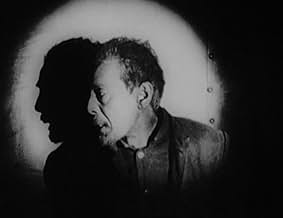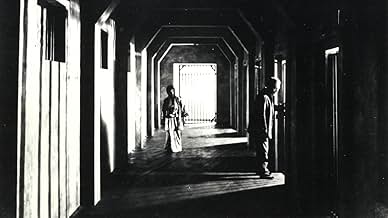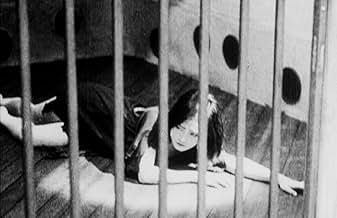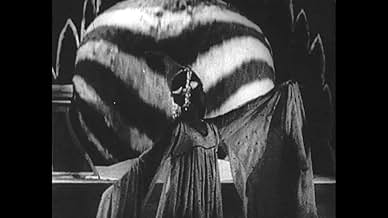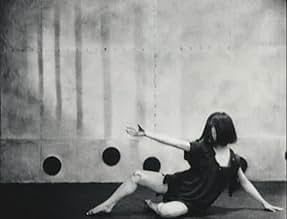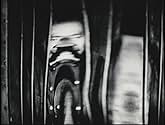VALUTAZIONE IMDb
7,3/10
5079
LA TUA VALUTAZIONE
Un uomo ottiene un lavoro in un manicomio nella speranza di vedere sua moglie.Un uomo ottiene un lavoro in un manicomio nella speranza di vedere sua moglie.Un uomo ottiene un lavoro in un manicomio nella speranza di vedere sua moglie.
- Regia
- Sceneggiatura
- Star
Recensioni in evidenza
10mjneu59
Film history has been negligent in recognizing this landmark silent drama, made in 1926 by pioneering Japanese director Teinosuke Kinugasa, but unknown until 1971, when a surviving print was (literally) unearthed in the director's garden shed. The film was produced in an isolated creative environment far removed from any foreign influence, but is nevertheless a masterpiece of imagery and editing, revealing a stunning visual flair and employing montage techniques as skillfully as anyone since Eisenstein. It tells a powerful, hallucinatory story of a janitor in an insane asylum who wants desperately to help his inmate wife after she attempts suicide, and like Murnau's 'The Last Laugh' unfolds without the crutch of intertitles. The film has aged remarkable little after the better part of a century in limbo, but since its belated rediscovery has yet to earn the acclaim and evaluation it deserves.
10quinolas
An old man works as a janitor in a mental hospital to be close to his wife who is a patient there and to try to get her out.
This is surely one of the most forgotten masterpieces of the silent era and an oddity in the history of Japanese cinema. Long thought lost, a print was found in the 70s and a music soundtrack added to it, which fits perfectly with the images. It might have been influenced by cabinet of doctor Caligary (director Kinugasa claimed he never saw the German film). However it surpasses it in style and in its more convincing (and chilly) portray of the inner mental state of the inmates in the asylum. To achieve this, the film makes use of every single film technique available at the time: multiple exposures and out of focus subjective point of view, tilted camera angles, fast and slow motion, expressionist lighting and superimpositions among others. It is also a very complicated film to follow, as it has not got intertitles.
The film opens with a montage of shots of rain hitting the windows of the hospital, wind shaking trees and of thunder. The unsettling weather metaphors the mental condition of the patients and introduces one of the them: a former dancer. The combination of sounds produced by rain, wind and thunder serves as the music that incites the dancer to get into a frantic, almost hypnotic dance. In another sequence involving the same patient engaged in another frenzied dance, she is being watched by other inmates. Multiple exposures of the dancer represent the patients' point of view and their confused "view" of the world.
These are just two examples from this amazing film trying to represent the patients' subconscious and view of the "sane" world.
In three words A MUST SEE.
This is surely one of the most forgotten masterpieces of the silent era and an oddity in the history of Japanese cinema. Long thought lost, a print was found in the 70s and a music soundtrack added to it, which fits perfectly with the images. It might have been influenced by cabinet of doctor Caligary (director Kinugasa claimed he never saw the German film). However it surpasses it in style and in its more convincing (and chilly) portray of the inner mental state of the inmates in the asylum. To achieve this, the film makes use of every single film technique available at the time: multiple exposures and out of focus subjective point of view, tilted camera angles, fast and slow motion, expressionist lighting and superimpositions among others. It is also a very complicated film to follow, as it has not got intertitles.
The film opens with a montage of shots of rain hitting the windows of the hospital, wind shaking trees and of thunder. The unsettling weather metaphors the mental condition of the patients and introduces one of the them: a former dancer. The combination of sounds produced by rain, wind and thunder serves as the music that incites the dancer to get into a frantic, almost hypnotic dance. In another sequence involving the same patient engaged in another frenzied dance, she is being watched by other inmates. Multiple exposures of the dancer represent the patients' point of view and their confused "view" of the world.
These are just two examples from this amazing film trying to represent the patients' subconscious and view of the "sane" world.
In three words A MUST SEE.
A Page of Madness is an expressionistic Japanese film that has not gotten the attention it deserves. I was introduced to the film through the fifteen part documentary series The Story of Film an Odyssey. Fortunately, a friend had dubbed the silent film off of Turner Classic Movies during one of its infrequent showings.
The clip in The Story of a Film an Odyssey looked like some mad movie genius had crossed the set designs from a German expressionist film with the fast edits of a classic Russian work. This clip was from the attention grabbing opening of A Page of Madness. A janitor wanders an insane asylum at night during a storm. The storm has a strange effect on the patients and, presumably, the attendant. The edits are fast, conveying mystery and terror like in a horror film. This sequence (and a sequence at the climax) is nothing short of brilliance.
From here the film turns to a narrative, although an oblique one. This clerk or janitor seems to have an unhealthy fixation on one of the female patients. . . and more of one for this patient's daughter. The janitor clearly knew this family before the mother was committed. IMDb says that the woman is the janitor's wife. I am not doubting this, but the film is not clear on this point. What is clear is that the janitor is suffering from a lack of love. This janitor is not the only one. One patient is compelled to dance suggestively and nearly starts a riot. By contrast, the doctors appear clinical and ineffectual. As the film goes along, the protagonist's mental state seems to wane.
Much about the plot is unclear. Many Japanese silent were narrated by a spokesman in the theater. This may have been the case with A Page of Madness; thus, some of the ambiguity would have been explained by the live narrator. I prefer to think the ambiguity was deliberate and never explained. The film has a wonderful sense of mystery to it. I don't want any more of an explanation. I (and probably most film fans) watch a lot of movies that are merely fair. These films are watchable, but they do not stay in one's memory. That is why A Page of Madness is so stunning. It kicks the door down and announces itself to the world. I feel less like a reviewer than a herald for a lost classic. Are you listening Criterion?
The clip in The Story of a Film an Odyssey looked like some mad movie genius had crossed the set designs from a German expressionist film with the fast edits of a classic Russian work. This clip was from the attention grabbing opening of A Page of Madness. A janitor wanders an insane asylum at night during a storm. The storm has a strange effect on the patients and, presumably, the attendant. The edits are fast, conveying mystery and terror like in a horror film. This sequence (and a sequence at the climax) is nothing short of brilliance.
From here the film turns to a narrative, although an oblique one. This clerk or janitor seems to have an unhealthy fixation on one of the female patients. . . and more of one for this patient's daughter. The janitor clearly knew this family before the mother was committed. IMDb says that the woman is the janitor's wife. I am not doubting this, but the film is not clear on this point. What is clear is that the janitor is suffering from a lack of love. This janitor is not the only one. One patient is compelled to dance suggestively and nearly starts a riot. By contrast, the doctors appear clinical and ineffectual. As the film goes along, the protagonist's mental state seems to wane.
Much about the plot is unclear. Many Japanese silent were narrated by a spokesman in the theater. This may have been the case with A Page of Madness; thus, some of the ambiguity would have been explained by the live narrator. I prefer to think the ambiguity was deliberate and never explained. The film has a wonderful sense of mystery to it. I don't want any more of an explanation. I (and probably most film fans) watch a lot of movies that are merely fair. These films are watchable, but they do not stay in one's memory. That is why A Page of Madness is so stunning. It kicks the door down and announces itself to the world. I feel less like a reviewer than a herald for a lost classic. Are you listening Criterion?
Kurutta ippêji (1926)
*** (out of 4)
Bizarre Japanese horror film has a man taking a janitor job at an asylum so that he can be closer to his wife who was committed after trying to kill their child. Had Luis Bunuel been bore in Japan and started making movies in 1926 then I'm guessing the final product would have came out looking like this thing. Lost for decades, it's easy to see why this film was never discovered but now that it's making its way around, it seems like this is destined to become something of a cult favorite to silent and horror fans. There's no straight story being told here, instead it's more avant-garde as we get all sorts of surreal images. We get the basic story but everything else is either told in flashback or through extra fast editing that helps build up the insanity of the lead character. Director Teinosuke Kinugasa really wants to get inside the mind of the insane and I think he does a pretty good job with it. At just 59-minutes the film moves at a pretty fast rate and a lot of this can be credited to the editing. I thought that the editing was the real star of the movie as it's done in such a fashion that you often see something but then you question what it was that you actually saw. You also have to try and keep up with what's going on and everything is happening so fast that you can see that the director was trying to use this to make the viewer feel what the characters were feeling being the asylum walls. There aren't any intertitles, which just adds to the visual image and the music score (done in the 70s) fits the film very well.
*** (out of 4)
Bizarre Japanese horror film has a man taking a janitor job at an asylum so that he can be closer to his wife who was committed after trying to kill their child. Had Luis Bunuel been bore in Japan and started making movies in 1926 then I'm guessing the final product would have came out looking like this thing. Lost for decades, it's easy to see why this film was never discovered but now that it's making its way around, it seems like this is destined to become something of a cult favorite to silent and horror fans. There's no straight story being told here, instead it's more avant-garde as we get all sorts of surreal images. We get the basic story but everything else is either told in flashback or through extra fast editing that helps build up the insanity of the lead character. Director Teinosuke Kinugasa really wants to get inside the mind of the insane and I think he does a pretty good job with it. At just 59-minutes the film moves at a pretty fast rate and a lot of this can be credited to the editing. I thought that the editing was the real star of the movie as it's done in such a fashion that you often see something but then you question what it was that you actually saw. You also have to try and keep up with what's going on and everything is happening so fast that you can see that the director was trying to use this to make the viewer feel what the characters were feeling being the asylum walls. There aren't any intertitles, which just adds to the visual image and the music score (done in the 70s) fits the film very well.
...from director Teinosuke Kinugasa. A man (Masuo Inoue) works as a janitor at a mental asylum in order to be near his wife (Yoshie Nakagawa), who is a patient. The man's daughter (Ayako Iijima) is to be married soon, and questions of attendance are making things difficult for the man.
This meager narrative provides the framework for a lot of flash-cut editing, strobing visual tricks, and experimental cinema. This isn't interesting as a traditional story (at least, not the existing version, which is said to be missing nearly a third of its original footage), but rather in depicting madness and inner turmoil in a visual fashion. Even the usual silent film intertitles are absent, rendering the film a purely visual experience. The score that was used on the version I watched seemed like it was suited for a late 1960s acid party. The original release was said to have had a narrator and traditional Japanese music accompaniment. What I saw was still an interesting viewing, much of it closer to experimental films from the 1960s than what I'm used to seeing from the 1920s.
This meager narrative provides the framework for a lot of flash-cut editing, strobing visual tricks, and experimental cinema. This isn't interesting as a traditional story (at least, not the existing version, which is said to be missing nearly a third of its original footage), but rather in depicting madness and inner turmoil in a visual fashion. Even the usual silent film intertitles are absent, rendering the film a purely visual experience. The score that was used on the version I watched seemed like it was suited for a late 1960s acid party. The original release was said to have had a narrator and traditional Japanese music accompaniment. What I saw was still an interesting viewing, much of it closer to experimental films from the 1960s than what I'm used to seeing from the 1920s.
Lo sapevi?
- QuizThis film was deemed lost for more than forty years, but it was rediscovered by its director, Teinosuke Kinugasa, in a rice cans in 1971.
- Versioni alternativeReissued in Japan in 1973 with musical score replacing original benshi.
- ConnessioniFeatured in Storia del cinema: Un'odissea: The Golden Age of World Cinema (2011)
I più visti
Accedi per valutare e creare un elenco di titoli salvati per ottenere consigli personalizzati
- How long is A Page of Madness?Powered by Alexa
Dettagli
- Data di uscita
- Paese di origine
- Lingue
- Celebre anche come
- Una pagina folle
- Luoghi delle riprese
- Kyoto, Giappone(Studio)
- Aziende produttrici
- Vedi altri crediti dell’azienda su IMDbPro
Botteghino
- Budget
- 20.000 JPY (previsto)
- Tempo di esecuzione
- 1h 10min(70 min)
- Colore
- Mix di suoni
- Proporzioni
- 1.33 : 1
Contribuisci a questa pagina
Suggerisci una modifica o aggiungi i contenuti mancanti

